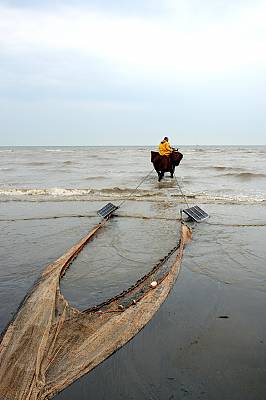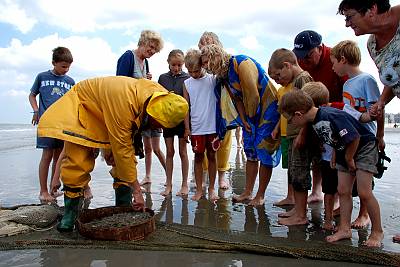Shrimp fishing on horseback in Oostduinkerke
Inscribed in 2013 (8.COM) on the Representative List of the Intangible Cultural Heritage of Humanity
Country(ies): Belgium
Identification
Description

- Shrimp fishing on horseback in Oostduinkerke
- © Dirk Van Hove, Gemeente Koksijde Paardenvissers_03 2009
Twelve households in Oostduinkerke are actively engaged in shrimp fishing: each has its own speciality, such as weaving nets or an extensive knowledge of Brabant draft horses. Twice a week, except in winter months, the strong Brabant horses walk breast-deep in the surf in Oostduinkerke, parallel to the coastline, pulling funnel-shaped nets held open by two wooden boards. A chain dragged over the sand creates vibrations, causing the shrimp to jump into the net. Shrimpers place the catch (which is later cooked and eaten) in baskets hanging at the horses’ sides. A good knowledge of the sea and the sand strip, coupled with a high level of trust and respect for one’s horse, are the shrimpers’ essential attributes. The tradition gives the community a strong sense of collective identity and plays a central role in social and cultural events, including the two-day Shrimp Festival for which the local community spends months building floats, preparing street theatre and making costumes. The shrimp parade, and a contest involving hundreds of children being initiated into shrimp catching, attract over 10,000 visitors every year. The shrimp fishers function on principles of shared cultural values and mutual dependence. Experienced shrimpers demonstrate techniques and share their knowledge of nets, tides and currents with beginners.
Documents
- Nomination form: English|French
- Consent of communities: English/Dutch
- ICH inventory - online resources: snapshot - inventory - element
Decision 8.COM 8.5
The Committee (…) decides that [this element] satisfies the criteria for inscription on the Representative List of the Intangible Cultural Heritage of Humanity, as follows:
- R.1: Shrimp fishing on horseback allows experienced shrimpers to pass on their knowledge and skills to younger generations, while providing the Oostduinkerke community with a sense of identity and respect for the marine environment;
- R.2: Inscription of shrimp fishing on the Representative List could increase the visibility of intangible cultural heritage in general and promote awareness of the importance of small, very local traditions, while underlining the close relations between humans, animals and nature, and promoting respect for sustainable development and human creativity;
- R.3: Past and current efforts made by the bearers themselves, the local governments and the State Party have contributed to the safeguarding of the shrimp fishing; several cross-cutting measures for its documentation, transmission and promotion are proposed, including national and international networking and community monitoring of the effects in case of inscription;
- R.4: Shrimpers and community representatives initiated the nomination and participated actively in its preparation, in cooperation with researchers, and provided their free, prior and informed consent for the inscription;
- R.5: With the participation of the concerned community, shrimp fishing on horseback in Oostduinkerke was included in 2009 in the Inventory of Intangible Cultural Heritage of Flanders, Belgium, carried out and regularly updated by the Arts and Heritage Agency of the Flemish Ministry for Culture.
Slideshow
Video
© 2010 by NAVIGO - Nationaal Visserijmuseum
These videos (and many more) can also be consulted through the UNESCO Archives Multimedia website











